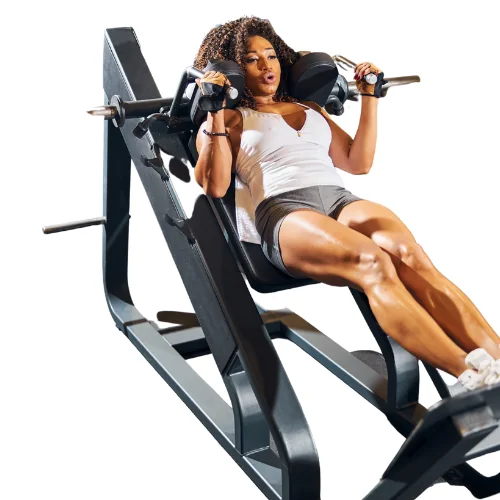If you want to get stronger, feel better physically and mentally, lose weight, age well, and/or look good naked, you need to do strength training. It’s that powerful.
In this definitive guide, you’ll learn everything you didn’t know you needed to know about strength training.
An important distinction: while strength training involves lifting weight (bodyweight or equipment), it is not weightlifting (one word). Weightlifting refers to Olympic weightlifting, which is professional competitions focused on two barbell lifts: the snatch and the clean and jerk.
Strength training, weight lifting (two words), and resistance training are all different terms for the same concept: picking up heavy shit and putting it back down again.
Welcome to the wonderful world of strength training. Get ready for your life to change.

What Exactly Is Strength Training?
Strength training is moving any weight during any exercise that pushes your muscles to rebuild stronger and prepare for the next challenge.
Whatever weight you’re using can vary from your body weight to kettlebells to barbells and more.
It also involves the concept of progressive overload. Put simply, progressive overload is using sliiiiiiightly more effort than the last time you did the exercise. You can either lift heavier weights or do one more rep. Either way, consistently putting in more effort is what forces your muscles to constantly be rebuilding themselves.
Examples of strength training (we’ll get into more detail on these later in the article):
- Bodyweight exercises like push-ups, pull-ups, etc.
- Dumbbell exercises like overhead presses, bicep curls, squats, etc.
- Kettlebell exercises like swings, the Turkish get-up, etc.
- Barbell exercises like squats, deadlifts, bench presses, etc.
- Machine exercises like leg presses, lat pull downs, etc.
Technically you could get down and do two knee push-ups right now, and that’s a strength training workout. Then, if you did three tomorrow, you’ve got your progressive overload.
That’s not so hard, right?
TL;DR: Strength Training = Moving Weight In Progressively More Challenging Ways.
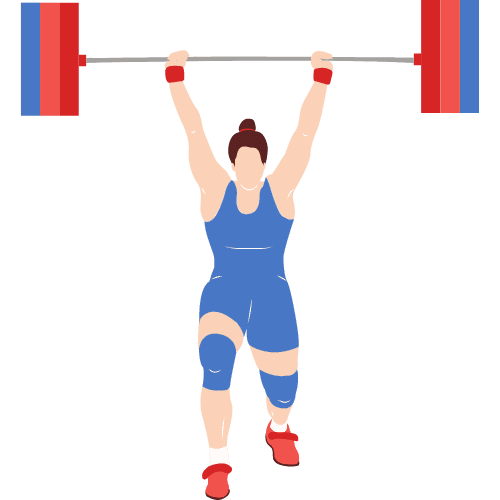
Why Should You Strength Train?
A better question would be: why shouldn’t you strength train. There are literally dozens of benefits of following a progressive strength training program. Here are just a few from study after study after study. Strength training:
- Increases your resting metabolic rate
- Reduces fat and helps control your weight
- Improves physical performance, including walking speed and functional independence (think: not needing help to get up as you age)
- Boosts cognitive abilities and brain health
- Improves self-esteem and mood
- Assists in the prevention and management of type 2 diabetes
- Enhances cardiovascular health (reduces resting blood pressure, decreases bad cholesterol, and boosts good cholesterol)
- Promotes bone development and density
- Reduces aches and pains like low back pain, arthritis, and fibromyalgia
- Reverses aging factors in skeletal muscle
- Make daily activities easier
All that sounds super rad, right? But how does it translate into everyday life? Think:
- Carrying all your grocery bags in one trip
- Carrying your children around the house
- Picking up a pet to put them in the car or on a table
- Pushing cars out of the snow or off to the side of the road
- Feeling super confident the next time someone sees you naked
- Impressing your doctor with your impeccable health
- Never needing help to load your suitcase into the overhead bins on the plane or into and out of cars
The list is practically endless.
TL;DR: If You Want A Better Quality Of Life, You Should Be Strength Training.

Who Shouldn’t Strength Train?
Short answer: No one. Everyone should be strength training.
It’s good for kids. It’s good for older adults. It’s good for paraplegics. We’ve already established above why it’s good for you. Strength training is so healthful it’s likely the one thing the fitness world can actually agree on: everyone should be doing it.
That said, always talk with your doctor before starting a new program. It’s also a good idea to consult a professional personal trainer and/or physical therapist to make sure your movement patterns are solid, and you’re not at risk for injury.
If you can’t afford a personal trainer — even for just a few sessions to make sure your form is solid — at least film yourself doing bodyweight moves and compare it to reputable YouTube sources.
However, you get started, just get started.
TL;DR: Everyone should be strength training. Period.

What If I Don’t Want To Get Bulky?
This question usually comes from women, and while I don’t want to alienate any females reading this, from one woman to another, I’m going to throw a bit of tough love your way:
Stop worrying about this.
Society has taught women that we need to take up less space, be satisfied with “long and lean muscles” (what does that even mean???), and be terrified of getting bulky or looking “manly.”
First of all, it’s literally impossible without extreme diets and drugs. Second, even if it were possible with your average Jane’s workout plan, it shouldn’t be something you’re afraid of. Think of it as getting bulky enough to smash the patriarchy.
Okay, I’ll get off my soapbox now and explain exactly why it’s not possible for women to get “bulky.”
Simply put, we don’t have the hormones.
Testosterone is the main hormone that drives muscle growth. Men have it in spades. Thus, they can look like Arnold Schwarzenegger if they train (and eat) for it. Women, on the other hand, have much less testosterone, so our chances of achieving the same look without drugs and/or eating literally 10,000 calories a day is very, very slim.
Those women you see (*cough* that society has taught you to be afraid of becoming *cough*) that are extremely muscular are bodybuilders whose literal entire job is to look the way they do. So chill, you won’t get “too bulky.”
And men, if you have this fear too, while it’s possible for you to get a bodybuilder’s physique, it doesn’t just suddenly happen from lifting weights.
The vast majority of your results come directly from your nutrition (for women, too). So if you don’t want to bulk up, consume fewer calories than you’re using during your day—simple math.
(Also, if you’re looking for a deep dive on how much protein you need to build muscle and how to build it fast and naturally, we’ve got you covered.)
TL;DR: Stop being afraid of getting bulky. You literally can’t without extreme measures.
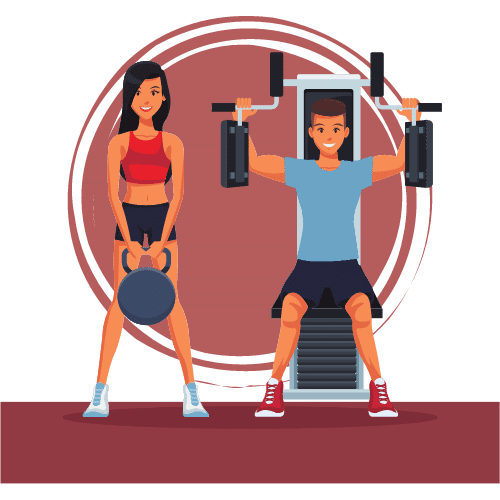
Do I Have To Join A Gym?
This is another one with a super short-and-sweet answer: nope.
Gyms can be excellent places to get fit if you join the right one for you. They’ve got the machines and equipment in one place, plus personal trainers if you’re able to go that route. However, they’re not essential for strength training.
The market is saturated with at-home gym equipment. And the good news is, if you’re brand spanking new to strength training, you can start with just your bodyweight and see results!
Then, as you get stronger, start investing in quality tools. Sets of adjustable dumbbells are great because they’re a one-time purchase that gets you an entire range of weights in small square footage. You can also use resistance bands though it’s a bit harder to track your progress.
If you get serious about strength training and have the space, a squat or power rack is an excellent investment.
TL;DR: Gym membership is absolutely not required. Just keep challenging your muscles, and you’ll make progress.
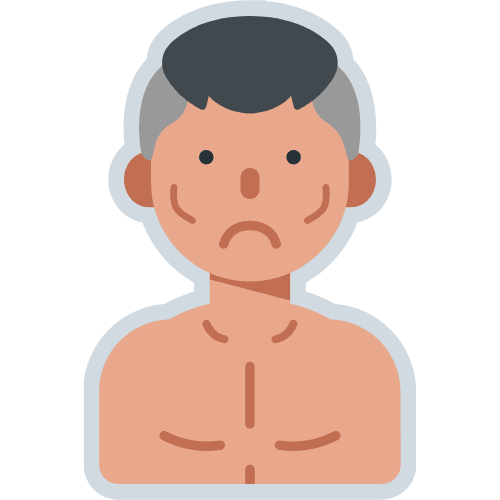
Am I Too Old For This Shit?
Remember above how I mentioned strength training is good for older adults? So, basically, no, you’re never too old to start!
Aging brings with it a host of potentially scary effects, including an increased risk of falling, cognitive decline, and loss of muscle mass (called sarcopenia). Research has shown that strength training exercises combat this weakness and frailty.
Lifting weights builds muscle strength and mass and helps preserve bone density. This means, if you’re older, you’re less likely to fall or need help moving around if you strength train at least two to three days per week.
Bonus: strength training can reduce the risk of osteoporosis, a condition in which your bones become weak and brittle and more prone to breaking.
Resistance training also improves sleep and reduces depression, both things older adults can struggle with.
In fact, strength training is so powerful, this study found it even reduced the risk of death! That’s right, picking up heavy things and putting them back down can actually lower your chances of dying. Enjoy a 41% lower risk of cardiac death and a 19% reduced risk of cancer death because you strength train.
TL;DR: You are never too old to start strength training, and it can even lower your risk of dying. Start lifting right now.
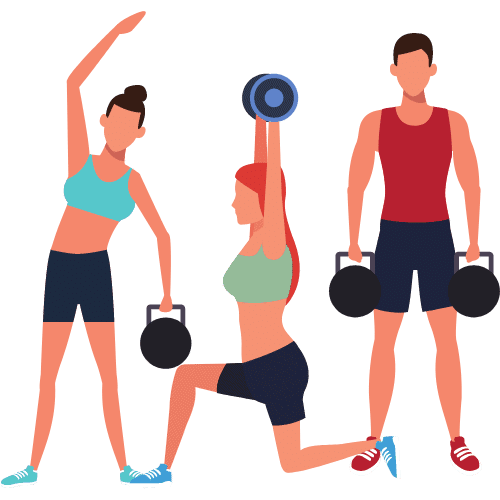
Types Of Strength Training
Not all strength training is created equal. Let’s dig into the different types.
Hypertrophy Training

Hypertrophy training is designed to get you bigger muscles. (Remember, you still won’t get “bulky,” even with hypertrophy training. Your muscle mass increases but not to bodybuilder levels.)
The science behind hypertrophy training still isn’t completely understood. However, it’s thought that mechanical load (the weight being lifted) is the key mechanism to activate muscle growth. Sustained tension on your muscles increases the post-exercise molecules responsible for increasing muscle protein synthesis.
What does that mean?
Lifting weights tells your muscles, “Hey, we were just under stress. Can you get bigger now, please, in case that happens again?” Then, of course, you do your next workout, so it happens again, and the process repeats.
Research also suggests the higher volume (sets and reps) you lift gets you greater muscle growth. A sample hypertrophy workout would look like 3–5 sets of 6–12 reps for each exercise. You’d work at about 75–85% of your one-repetition maximum (1RM) and rest for 1–2 minutes between exercises. With hypertrophy, you’ll also lift more slowly than other types of training.
A note about 1RM
Your 1RM is the amount of weight you can lift for literally a single repetition and be unable to do a second one. Testing for this is tricky and is best done with a personal trainer. If you can’t afford that, there are calculators and formulas online you can search for.
When training for hypertrophy, the progressive overload principle still applies. You need to either be lifting heavier or adding a rep every 2–4 weeks or so as you progress. Also, build in “deload” periods every 4 weeks where you lift much lighter and with fewer reps. This helps reprogram your muscles, so they get resensitized to the heavy lifting when you pick it back up the following week.
Another way to progress includes trying new exercises. Swap out a push-up for a bench press, for example. Or, do sumo squats instead of regular ones. Subtly changing the movement will activate your muscles in different ways, which again makes them build themselves back up larger.
Finally, you can utilize eccentric overload. Concentric movement is the lifting of the weight, and eccentric is when you lower it. For example, in a bicep curl, concentric is lifting the weight to your shoulder, and eccentric is lowering it back to your side.
Eccentric movements actually cause more damage to your muscles than concentric. Try lowering the weights in various moves much more slowly than you lifted them.
TL;DR: Hypertrophy is training to increase muscle mass and size.
Explosive Strength

This type of strength training is perfect for athletes or sports players. It’s been shown to improve performance in endurance sports like a 5K run. It’s also been proven to improve vertical jump in basketball players.
It’s also great for everyday folks who want to be able to react to sudden situations in their lives more quickly and safely.
For example, say your kid is running full-tilt toward the street after their favorite ball. Could you catch them? Or, say your face is buried in your phone as you’re walking (no judgment), and you suddenly step off a curb that was much higher than you noticed. Could you avoid falling?
Explosive strength training is working your muscles with the goal of quick reactivity and rapid-fire strength.
An explosive strength workout could look like 3 sets of 5–10 reps of each exercise with no rest between them. You’d rest 2–3 minutes between sets and work at progressively lower intensities. For example, your first set would be 85–100% intensity, the second at 30–45% intensity, and so on.
Include moves like a barbell squat, box jump, heavy ball throws, etc. Anything that uses large muscle movements and quick execution.
TL;DR: Explosive strength training is perfect for athletes and those who want to move exceptionally quickly and safely in everyday life.
Speed Strength
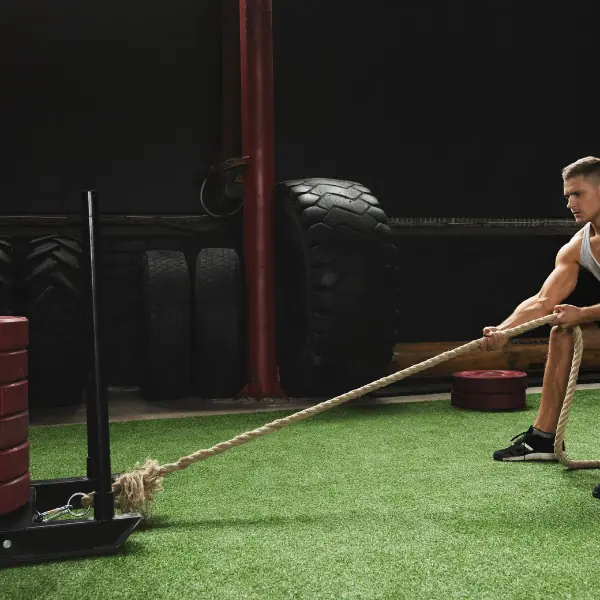
Training for speed strength is similar to explosive strength. Your goal is to get the greatest muscle activation in the shortest time. The difference is that speed-strength also has a focus on starting strength.
Starting strength is the force you use in the first 30 milliseconds of a concentric contraction. Explosive strength is then continuing that movement as fast as possible.
Why would you want to speed train? Again, similar to explosive training, it develops your ability to react to stimulus very rapidly. Studies have also shown fast training can increase strength and speed development by 20% more than other types of training. So if you want results faster and don’t care about the physical size of your muscles, explosive and speed training may be a good fit for you.
Speed training can also help if you want to get into Olympic weightlifting. The lifts in weightlifting (the snatch and the clean and jerk) require rapid, explosive movements. To do so safely, you need to know how to strength train with speed.
A sample speed training workout could look similar to explosive strength in terms of reps, sets, and lack of rest between exercises. You’d also add plyometric exercises and possibly sprints or agility drills.
TL;DR: Speed strength training is similar to explosive except with a prioritization of starting strength.
Muscular Endurance
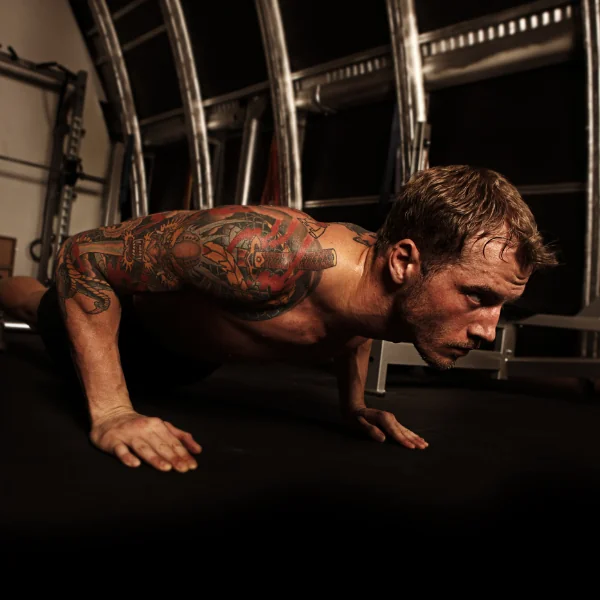
Muscular endurance is the ability to hold a position for a long time or do the same motion many times. Think how long you can hold a plank or how many times you can do a bicep curl.
Endurance is a critical aspect of strength training. After all, the idea is to be either continuously adding weight or another rep so that you’re always getting stronger. Improving your muscular endurance is a way to do just that.
A muscular endurance workout could look like 2–4 sets of a high rep range, like 15–20. The rest period between sets is short, around 30 seconds. Your goal isn’t to lift super heavy in these workouts. Instead, doing higher reps forces your muscles to work for longer periods, building their endurance.
You can do a lot of the same moves as hypertrophy or other strength training, like barbell squats, kettlebell swings, calf raises, etc. Just keep those sets short and reps high.
TL;DR: Muscular endurance lets you do the same motion many times.

Strength Training Benefits
Build a Kick-Ass Body with Lean Muscle Mass
Time to talk about an issue that most people feel is important to them — looking good naked (or in a bathing suit).

Strength training allows you to build a kick-ass body. There’s a reason most celebrities include it in their fitness routines. As you build lean muscle mass, you lose body fat (more on that below), which translates to a tighter body.
If aesthetics are important to you, you gotta do strength training.
Now, it’s important to note that not everyone who starts strength training will suddenly become a magazine model. Photos on social media and magazine covers are heavily photoshopped and edited, not to mention being chosen out of 19,375,912 photos in the shoot. So if you’re expecting to go from couch potato to Angelina Jolie, think again.
That said, you do have the opportunity to lean out and build a muscular body with strength training. A lot of it (like 90%) will depend on your nutrition. (Check out our beginner’s guide to nutrition for more info.)
TL;DR: Look good naked when you strength train.
Reduce Your Body Fat Percentage
As mentioned in the kick-ass body section, strength training allows you to reduce your body fat percentage. Keep in mind you’re not “replacing” fat with muscle or even “burning” it, for that matter.
Rather, muscle requires your body to use more calories to maintain it than fat does, even while you’re resting. So by adding muscle to your body, you’re automatically boosting your metabolism. Combine that with a caloric deficit, and where does your body turn for energy? Your fat stores.
Top it all off with a few sessions of various types of cardio each week, and you’ve got a solid recipe for reducing your body fat percentage.
TL;DR: Strength training builds muscle which boosts your metabolism, resulting in fat loss.
Lose More Fat… for Good
Okay, so you know strength training helps reduce your body fat percentage. Did you know it also helps you keep that weight off for good?
To get the full advantage of this benefit, you have to train consistently. You can’t just follow a program for a few months, lean out, then stop lifting altogether and expect your muscles to just magically remain.
That said, if you lift consistently for years, the fat you lost at the beginning of your exercise journey is unlikely to return. As long as you’re progressively overloading your muscles, you should stay lean.
Overloading doesn’t have to always look like adding another rep or going up in weight, either. You can try taking two weeks off to let your muscles rest or shaking up your routine with a new exercise or form of cardio. The point is that human bodies are excellent at adapting to stimulus, so at roughly the 12–16 week mark, change something to keep those muscles primed and that fat banished.
TL;DR: Enjoy permanent fat loss with consistent training.
Improve Your Body Image

If you struggle with body image — male, female, or however you identify — you’re not alone. Studies vary, but, in general, 20–40% of women and 10–30% of men are unhappy with their bodies.
First, a quick definition: your body image is how you see yourself or how you perceive that others see you. Note that it’s not how you actually look; it’s how you see yourself. That’s why it’s such a struggle for so many people. We don’t see ourselves clearly.
So, if you look in the mirror and have less-than-positive thoughts about your body image, strength training can help. It’s not only thanks to the boost of lean muscle and loss of fat, either.
Strength training is excellent for improving your body image via how much you’re lifting and the ways it shows up in your everyday life. Imagine the rush of endorphins when you finally conquer deadlifting your bodyweight or take over lifting something heavy for your “fit” friend.
TL;DR: Strength training makes you feel like a badass, thus improving your body image.
Boost Your Metabolism
We touched on this in the fat loss section, but strength training is an excellent way to boost your metabolism. It improves your cardiorespiratory fitness and resting metabolic rate (RMR). Your RMR includes how many calories you burn when you’re at rest. That’s about 50–70% of your daily caloric expenditure.
Let that sink in: at least half of the energy (calories) your body uses every day is happening when you’re... doing nothing. Breathing, keeping your heart beating, your brain functions — all those daily tasks your body does that you don’t think about take a lot of calories.
Wouldn’t you like that number to be closer to the 70% range? That’s where strength training comes in. Remember, muscle requires more energy to maintain than fat. So when your body is at rest, it’s working harder to keep your muscles together than to keep your fat stored.
Plus, a faster metabolism means you can eat more food. It’s a win-win!
TL;DR: Your resting metabolic rate gets a boost with strength training.
Boost Your Cardio Level

Remember how I said above that strength training improves your cardiorespiratory fitness? While cardio is essential and does improve your cardiovascular system, strength training helps, too.
It goes so far beyond just being able to walk up a flight of stairs without getting out of breath, too. Improving your cardio health actually:
- Helps your heart and blood vessels improve their ability to pump blood throughout your body
- Improves your lungs’ ability to take in oxygen and transfer it to your blood
- Helps your muscles become more efficient in using that oxygen
Remember in the very beginning, when I said strength training reduces your blood pressure, lowers bad cholesterol, and raises good cholesterol? Yep, here we are. It also reduces the risk of heart attack and improves your sleep.
TL;DR: Enjoy improved cardiovascular health thanks to strength training.
Improve Your Energy Levels
Speaking of sleep, strength training can boost your energy levels. Exercise enhances blood flow, carrying oxygen and nutrients to your muscle tissue.
This improves the muscles’ ability to produce more energy, thus boosting your energy levels.
So even if you’re tired, pick up those dumbbells! (Or barbell, or bands, or your body, you get the idea.) If you’re sluggish starting out, that’s okay.
Your body will soon kick into gear to help you complete the workout. And when you’re done, you’ll have more energy!
TL;DR: Strength training boosts blood flow and, thus, your energy levels.
Improve Your Posture, Flexibility, and Range of Motion

If you’re older or sit in front of a screen all day (and chances are, you’re one or the other or both), your posture is likely taking a hit. Whether you sit slumped over a laptop or at ease on the sofa, your shoulders and neck may round forward a bit.
Enter the magic of strength training (seriously, is there anything it can’t do for us?). To improve your posture, focus on core exercises — and I don’t mean crunches. Your core is so much more than just your abs. When trainers say “core,” they actually mean every muscle that extends from your shoulders down to your pelvic region, including your pelvic floor muscles.
Think rows to work your lat muscles and pull your shoulders back. Leg lowering exercises to strengthen your lower abs. Cobra pose to extend your spine and help with slouching. Planks of all kinds to strengthen, well, everything. (Guaranteed we’re all not doing enough planks, work them into your routine asap if it’s safe to do so.)
Strength training also improves your flexibility and range of motion, both of your joints and in general. Regularly putting your joints through their full range of motion (squats, bench presses, etc.) helps them stay supple and strong.
TL;DR: Slouching posture, flexibility, and range of motion all get exercised when you lift.
Strengthen Your Bones
How on earth does moving your muscles strengthen your bones? I’ll tell you!
Your muscles are connected to your bones via tendons. When you move your muscles, your tendons go to work to move the bones. You can see this in action if you wiggle your fingers and watch the back of your hand.
So, when you strength train, you’re moving muscles which are moving tendons which are moving bones. That triggers your bone-forming cells into action with a flag of, “Hey! Something heavy is happening to us, can we get a little help here?” and boom, bone growth. It’s sort of like what happens to your muscles when they get those tears that self-repair into stronger tissue, except without the tearing.
Why should you care about strong bones? Whelp, you’re going to get older eventually (if you aren’t already), and as you age, your muscles and bones start to weaken. This translates directly into poor balance and an increased likelihood of falling.
TL;DR: If you don’t want to be the butt of the “grandma broke her hip” joke, pick up some weights.
Reduce the Risk of Injury

The likelihood of falling and breaking a bone does increase as you get older; however, even young folks are at risk of serious injury. You could trip while walking down the sidewalk, your dog could pull you over in a frenzied rush for a squirrel, or you could slip and fall in the shower.
There are literally dozens of ways you can get hurt every day. But it’s not all doom and gloom! Strength training not only gets you stronger muscles and bones, but it also helps with your balance. How? Those tiny stabilizer muscles in your feet, ankles, knees, and wrists all get worked when you strength train.
Think about a single-leg deadlift. Your foot — whether you’re aware of it or not — is constantly making micro-adjustments to help you keep your balance. Those micro-adjustments are thanks to your stabilizer muscles. That’s not even mentioning how your core is working to stabilize you in basically every workout move ever.
TL;DR: Strong stabilizer muscles + strong core = less risk of injury.
Reduce the Likelihood of Many Chronic Conditions
Remember when I mentioned that strength training helps in the prevention and management of type 2 diabetes, reduces the risk of heart attack, and can help with aches and pains from conditions like arthritis and fibromyalgia? It’s all true.
It can also help with movement disorders like Parkinson’s and MS. The science behind it still isn’t clear, but so far, folks with these conditions report improved symptoms.
Studies have also shown it can help reduce cancer risk and symptoms, help with orthopedic conditions, reduce the likelihood of neurological disorders, and help with depression.
Again, if you’re not already doing bicep curls with one hand while scrolling this article with your other hand, I don’t know what to tell you.
TL;DR: Start Strength Training — Yesterday — To Reduce The Likelihood And Symptoms Of A Dozen Different Chronic Conditions.

Busting Myths About Strength Training
You’ve likely heard a few different pieces of “essential” advice, either from the bro lifting across from you or from the endless information on the internet. Whelp, I’m here to bust the three top strength training myths that seem to show up everywhere.
We already covered the myth that strength training will “bulk” you up, so I won’t revisit that one here. But for reals, and it bears repeating: it won’t.
1. Supplements and Protein Shakes Are a Must After Your Workout
The supplement and protein powder industry would love for me to tell you this one’s true, but sorry, it just isn’t. If you’re eating a well-balanced diet full of lean meats or vegetarian protein sources, whole grain carbs, and fresh fruits and veggies, supplementation and protein powders just aren’t necessary.
Now, if a shake is the most convenient way for you to get a hit of protein after your workout as you’re rushing to the office or to pick up the kids, that’s fine. Just make sure you include fresh or frozen fruit, a handful of greens, and your protein source of choice (can be powder but can also be other sources like peanut butter or Greek yogurt).
Some folks may find it challenging to get enough protein without powder or have specific dietary needs that require supplementation. But in general, most of us do just fine getting enough protein in our daily diets.
TL;DR: Eat a healthful, balanced diet, and you won’t need supplements.
2. You Can Spot Tone
Ever see someone doing a zillion crunches because they think it will get them a six-pack? Spoiler alert: it won’t. It’s literally impossible to zero in on one area and lose fat from just that spot.
Where you lose fat first is 100% genetically determined and varies from person to person. In general, women carry more fat around their lower belly, hips, and thighs. Men tend to carry more around their midsection.
No matter your gender, your body will lose fat from where it wants to when it wants to. Now, you can absolutely do extra tricep extensions if you want to strengthen that muscle. But it’s not going to lose you any extra fat from just that area alone.
TL;DR: You can’t spot tone for fat loss. Period.
3. “No pain, no gain.
If I could smack whoever originally said this… but I digress. Feeling uncomfortable during your workout is one thing; pain is another.
Pain is your body’s way of telling you something is very wrong. If you feel pain during your exercise, stop immediately. If your muscles are so sore the next day that you can barely move, you’re going too hard. Dial it back a notch or two to avoid injury.
TL;DR: Pain = bad. Ease up if you’re experiencing extreme soreness.
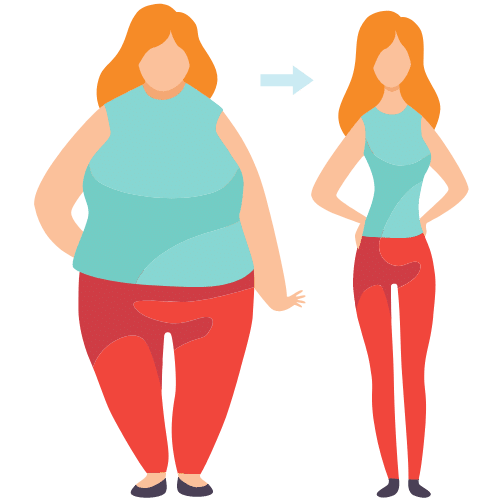
Can I Use Strength Training To Lose Weight?
Short answer: absolutely! The key is to be in a slight caloric deficit (using more calories than you consume).
Notice the key word in that sentence: slight.
Somehow the idiotic notion that you should be eating 1200 calories a day to lose weight gets constantly circulated around the fitness industry, and it’s nonsense. Instead, use a daily calorie estimator (like this one or this one or a super in-depth one like this) to figure out how many calories you should be eating per day.
Then, subtract only 300–500 calories per day for weight loss. That’s it, that’s your caloric deficit.
Remember, the point of strength training is to build muscle, which boosts your metabolism and helps your body use fat for fuel. To build muscle, you need to be consuming adequate calories for your age, activity level, gender, etc. To lose weight, you also need to be in a deficit. The balancing act comes with the slight reduction in calories consumed.
TL;DR: Yes, with a slight caloric deficit of only 300–500 calories less per day.

Before You Start!
Okay, you’re sold on the dozens of benefits of strength training, and you’re ready to dive in. Not so fast! There are a few key things to keep in mind.
Set Your SMART Goal
A SMART goal is one that’s Specific, Measurable, Achievable, Realistic, and Time-Based. It’s essential to have a SMART goal because it will guide every action you take.
You can’t just say, “I want to lose weight” or “I’m going to start strength training.” Those are too vague and won’t get you anywhere.
Try something along the lines of, “I will strength train 2 times per week for 45 minutes per session (specific, measurable, and realistic) for 12 weeks (time-based) with the goal of losing 8% of my body fat (again, specific, measurable, and realistic.).”
TL;DR: A SMART goal will give your fitness journey essential guidance.
Get a Meal Plan that Fits Your Goal
Remember how nutrition is responsible for the vast majority of your results? You can spend hours and hours in the gym and see very little progress if your nutrition isn’t backing up your training.
Aim for 1.6–1.7 g protein per day per kg of your body weight. Prioritize lots of fresh fruits and veggies. Eliminate as much sugar and refined carbs as you can. Replace unhealthful fats (fried foods and butter) with healthful ones (avocado and olive oil).
TL;DR: Most of your results will come from your nutrition, so dial it in.
Seek Professional Advice
If you’re able to, you’ll likely have much greater success if you consult the professionals. A certified personal trainer will be able to correct any form issues you have. They also have the knowledge to look for muscular imbalances or mobility issues.
A certified nutritionist can help you take a look at your available options and make any necessary swaps. Some even develop meal plans for you, so you don’t have to do the work.
TL;DR: Consult trainers and nutritionists if you can.
Don’t Forget to Warm Up
You absolutely must warm up before you exercise. Period, no exceptions.
A good warm-up dilates your blood vessels, ensuring your muscles are supplied with oxygen. It also raises muscle temperature so they’re more flexible and can work more efficiently. Warming up also slowly raises your heart rate, minimizing stress on the organ.
TL;DR: Warming up primes your body for movement and helps avoid injury. Don’t skip it.
Focus on Compound Exercises
Compound exercises work multiple muscle groups at once. They’re the best way to get the most bang for your buck during your workout. They burn more calories, improve coordination, and elevate your heart rate more effectively.
Examples of compound exercises include squats, deadlifts, bench presses, lunges, and pull-ups. Examples of the opposite, isolation exercises include bicep curls, tricep extensions, and calf raises.
That’s not to say you should skip isolation exercises entirely; they have their place. Prioritize compound moves at the beginning of your workout when you’re fresh and energized. Place isolation moves at the end when you’re fatigued.
TL;DR: Do compound moves for the most efficient workout.
Learn the Proper Form for Each Exercise
I touched on this earlier, but it bears repeating. Learn the proper form for every exercise you’re going to attempt. At the most basic level, this helps prevent injury.
Learning proper form also ensures you’re working the muscles you intend to work. For example, if you’re deadlifting improperly, you’re likely using your lower back. The exercise is designed to fire your entire posterior chain, from your lats to your hamstrings. You risk doing all the work without actually building the desired muscles when you ignore your form.
Your best bet is to work with a trainer or, again, find reputable video sources online.
TL;DR: Proper form is essential, don’t skip learning it.
Do NOT Overtrain
This ties back into the “no pain, no gain” situation. If you’re training so hard that you can barely move, you’re going too hard. If you’re not giving yourself days off between training, you’re going too hard.
The real work of muscle and strength building happens on the days you aren’t lifting. That’s right, your rest days are when the magic happens. Make sure you have at least 1 complete rest day between working the same muscle groups. Otherwise, the muscle never has a chance to repair itself, and it doesn’t get stronger.
TL;DR: Overtraining is bad. Prioritize your rest days.
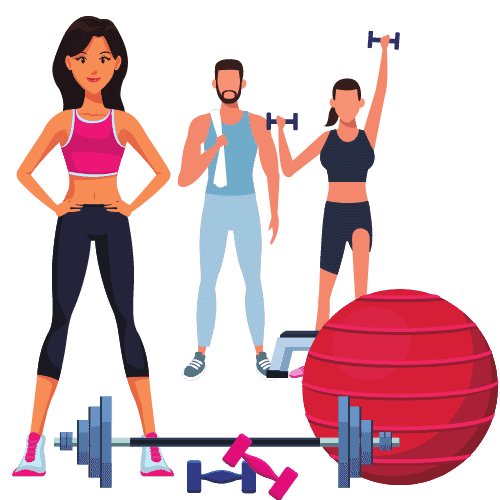
Choose Your “Style”
You’ve figured out the type of strength training you want to do, set your SMART goal, and have your nutrition set. Excellent, you’re ready to start lifting. Now, choose your style.
Bodyweight Training

You can absolutely make strength gains with just your body weight. Beginners will see rapid progress (affectionately known as “newbie gains”) as their muscles adapt to new stimuli. As you get stronger, you’ll need to adjust your training.
Ways to make bodyweight moves harder include:
- Adding a pause mid-movement (holding your squat for a few seconds at the bottom)
- Doing 1.5 reps (do a squat, come back up, go down halfway, come back up, that’s your whole rep)
- Slow the movement way down
- Do a burn-out set with pulses
- Add a jump or other plyometric movement
Examples of bodyweight exercises:
- Push-up
- Pull-up
- Squats
- Lunges
- Planks
TL;DR: Bodyweight is great for beginners or those without access to equipment.
Dumbbell and Barbell Training
Most of the moves you can do with a barbell you can do with dumbbells. Both options are great ways to add weight to your moves and keep getting stronger. Both also require excellent attention to form to avoid injury as you increase the weight.
Examples of dumbbell and barbell exercises:
- Barbell back squat
- Dumbbell Romanian deadlift
- Dumbbell overhead press
- Barbell hip thrust
- Dumbbell Turkish get-up
TL;DR: Dumbbell and barbell training are extremely effective for adding weight to your exercises.
Weight Machines Training
There’s a lot of debate in the fitness world about whether machines or free weights are better. The truth is, both can get you stronger.
Examples of weight machine exercises:
- Shoulder press
- Leg press
- Lat pulldown
- Chest press
- Cable pull through
TL;DR: If you have access to weight machines, they can be an excellent way to build strength.
This one’s tricky because it will vary so much from person to person. The easiest way to think about it is: what equipment do you have access to, can afford, or have space for?
If you live in a small house or apartment, a set of adjustable dumbbells may be best. If you have access to a gym, consider weight machines or barbell training. If you have space in your garage to set up a home gym, a barbell training regime might work for you. If you have none of that, rely on your body weight.
If you have the flexibility to make all of those things happen, you’re very lucky! Consider giving them each a try before you choose one or mix and match throughout your exercise journey.
TL;DR: This one will take a bit of experimenting to figure out.
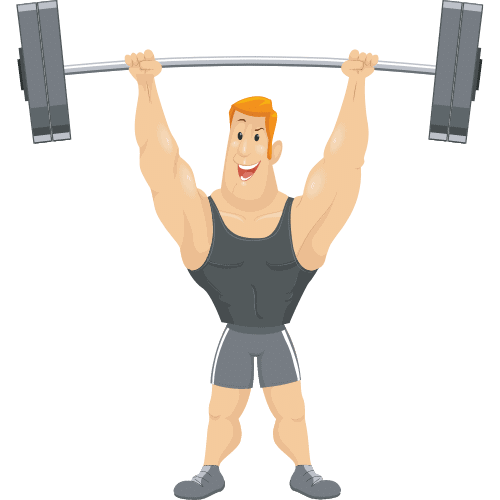
How Much Weight Should I Be Lifting?
If you’re brand spanking new to exercise, I recommend starting with your body weight.
This will not only help you avoid injury but will also help you nail down your form. For moves that need equipment like deadlifts, hold a broomstick or a piece of PVC pipe.
Once you’ve got your body weight moves down pat, you can start adding weight. If you’re barbell training, begin with just the empty bar (it weighs about 45 pounds). If you’ve got dumbbells, start with just 5 pounds.
As you get stronger, add weight in 2- to 5-pound increments.
TL;DR: A good rule of thumb is: when in doubt, go for a lower amount. You can always add more!
What About Sets and Reps?
If you’re following one of the types of strength training I mentioned above, the sets and reps are in that section. For a refresher:
- Hypertrophy training: 3–5 sets of 6–12 reps for each exercise, rest for 1–2 minutes between sets
- Explosive strength: 3 sets of 5–10 reps of each exercise, minimal rest between sets
- Speed strength: similar to explosive
- Muscular endurance: 2–4 sets of a high rep range, like 15–20, 30 seconds rest between sets
A few other common rep ranges for beginners are:
- 5 sets of 5 reps
- 3 sets of 8 reps
- 3 sets of 10 reps
If you’re “failing” meaning you can’t complete the lift with proper form before you reach the desired reps, you need to go down in weight.
TL;DR: Another trial-and-error here, people. Experiment with different sets and rep ranges to see what works for you!
How Do I Know When to Add More Weight?
When you’re consistently (at least two workouts in a row) completing your set and rep ranges and feel like you could do 3 more, add some weight. Or add more reps, either one.
TL;DR: Do you really need one of these here?
How Often and How Much Time Should I Train?
This will depend largely on your goal and schedule. However, the American Heart Association recommends at least twice per week. The length of each workout will vary widely depending on your style and type. Most last anywhere from 30 to 90 minutes.
TL;DR: Strength train twice per week.

Wrapping It Up
Strength training has dozens of benefits. It’s suitable for basically everyone to do and is fun to boot. Don’t wait to add this essential type of exercise into your routine. It’s never too late to start lifting!


